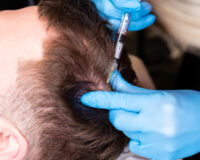As more and more people look for minimally invasive aesthetic treatments, sclerotherapy has become an option for those looking for solutions for vascular concerns.
Sclerotherapy is a treatment that can target and eliminate unwanted veins, giving clients clearer and smoother skin.
The chance of developing varicose veins increases as we age, as the walls and valves of veins lose their elasticity, becoming stiff. If your vein walls cannot work properly, blood starts to collect inside the veins, causing purple and blue swellings underneath the skin.
Sclerotherapy can be used to treat noticeable varicose veins, while micro sclerotherapy is better for smaller spider veins that are nearer the skin’s surface.
This raises the question, how effective is sclerotherapy for spider veins?
In short, research has shown that sclerotherapy can improve the appearance spider veins by 50%-70%, making it a highly effective treatment for reducing their visibility.
However, it’s key to note that multiple sessions are needed to achieve optimum results, while individual outcomes may vary depending on factors, including age, gender, and overall circulation health.
We’ll cover more about the effectiveness of sclerotherapy below, including how long it takes to work, whether the treatment is safe, and why aesthetic practitioners should consider adding sclerotherapy to their skill set.
How Does Sclerotherapy Work?
Varicose veins and spider veins are generally not dangerous, but they can cause discomfort.
The NHS states that common symptoms of varicose veins include aching, tingling, tiredness, and a feeling of heaviness in the legs. While spider veins are usually asymptomatic, they can sometimes lead to itching or mild discomfort in rare cases.
Beyond physical symptoms, the appearance of both varicose and spider veins can be a significant source of self-consciousness, especially when they are visibly located in prominent areas, like the face.
Sclerotherapy is a minimally invasive procedure designed to treat varicose and spider veins. During the treatment, a special solution, known as a sclerosing agent, is injected into the targeted veins.
Sclerosing agents irritate the lining of blood vessels so they become sticky. Blood cells then start to collect in the area, forming a scar. This closes the veins off, improving their appearance and leaving clear skin behind.
After your consultation, your aesthetic practitioner will sanitise the treatment area and use a thin needle to inject the sclerosing solution directly into the vein. Following the injection, a small bandage will be applied to the site, like the one you’d receive after a vaccination.
Once the procedure is finished, clients may be asked to wear compression stockings for a short period, as this improves circulation and the effectiveness of the treatment. There might be some initial bruising or swelling, but minor side effects typically subside on their own.

What Is The Difference Between Sclerotherapy and Microsclerotherapy
The main distinction between sclerotherapy and microsclerotherapy is the size of the veins being treated. Sclerotherapy is typically used for larger, more prominent varicose veins, while microsclerotherapy targets smaller, superficial veins, like spider veins.
In traditional sclerotherapy, a variety of needle sizes may be used depending on the size of the varicose veins being addressed. Microsclerotherapy, on the other hand, uses much finer needles to accurately treat the thinner, more delicate veins nearer the skin’s surface.
Additionally, the sclerosing agents used for sclerotherapy are often formulated in different concentrations to accommodate larger varicose veins, in contrast to smaller ones used to treat fragile spider veins in micro sclerotherapy.
How Long Does It Take For Sclerotherapy To Work?
The effectiveness of sclerotherapy depends on the size of the veins you’re attempting to treat.
The results of smaller spider veins typically become visible between 3 and 6 weeks. Larger veins may require more time, usually between 3 and 4 months, while additional sessions may be needed to achieve desired results.
Veins that respond well to treatment typically don’t reappear, but it’s important to remember that new veins may develop over time. If further sclerotherapy treatments are necessary, there’s generally a waiting period of about six weeks between sessions.

How Safe Is Sclerotherapy?
Sclerotherapy is generally safe for most people, but like any aesthetic treatment, it can have some side effects.
Common side effects of sclerotherapy include:
- Hives
- Skin irritation or sores
- Bruising
- Darkened skin
- Visible small blood vessels
These side effects usually resolve within a few days or weeks, though some may take longer.
Less common side effects can include:
- Inflammation
- Blood clots
- Air embolism (bubbles in the blood)
- Allergic reaction to the sclerosing agent
If blood clots develop, they may need to be drained. While very rare, clots can occasionally move to deeper veins, potentially causing a pulmonary embolism, which requires prompt medical attention. However, such events are extremely uncommon.
Sclerotherapy may not be suitable for everyone. It is generally recommended to avoid the treatment if you are:
- Pregnant or breastfeeding
- Have a history of deep vein thrombosis (DVT)
- Live with diabetes
- Have asthma
- Allergic to the sclerosing agent
- Unable to walk or have limited mobility
- Have experienced previous blood clots
How To Prepare For Sclerotherapy
Selecting a qualified, experienced practitioner is crucial when preparing for sclerotherapy. Look for a professional who has completed proper training through accredited aesthetic courses to ensure they can perform the procedure safely and effectively.
A well-trained practitioner will thoroughly assess your condition and tailor the treatment to your individual needs, helping to achieve the best possible results.
In addition to choosing a qualified aesthetic practitioner, here are some other steps to help prepare for your sclerotherapy session.
1. Consultation and Assessment
During an initial consultation, a practitioner will assess your health and medical history to determine if sclerotherapy is the right type of aesthetic treatment for you.
Be prepared to discuss any underlying health conditions, current medications, and previous treatments.

2. Avoid Blood Thinners
Avoid ibuprofen, aspirin, and other blood thinners to reduce the risk of bruising or bleeding during the procedure.
Always consult your medical provider before stopping any medication.
3. Wear Loose Clothing
Wear loose, comfortable clothing on the day of your treatment so the practitioner can access the treatment area easily.
Refrain from shaving and avoid tight clothes, jewellery, or lotion, as this could irritate the skin.
4. Aftercare Preparation
Be prepared to follow aftercare advice, which may include wearing compression stockings to support the treated veins.
You may also be advised to avoid prolonged sitting or standing for a few days after the procedure.
How Can We Help
So, how effective is sclerotherapy for spider veins?
To sum up, sclerotherapy is a very effective treatment for spider veins, but these results can vary based on vein size. Smaller spider veins typically fade within 3-6 weeks, while larger veins may take between 3 and 4 months. New spider veins can develop, but treated veins typically don’t return, making sclerotherapy a great treatment to achieve smoother skin.
If you’re an aesthetic practitioner looking to expand your skill set, adding sclerotherapy to your services can be a valuable way to meet growing demands and offer clients high-quality treatments.
At You Can Clinic, our Sclerotherapy course focuses on micro sclerotherapy, providing in-depth knowledge on treatment effectiveness, potential side effects, and the anatomy and physiology relevant to the procedure.
Located in state-of-the-art facilities in Cardiff and Bristol, the course also includes a live demonstration with real models, helping you improve your skills and deliver this treatment with confidence.
Ready to take the next step? Give us a call on +44 (0)2921 678747 to find out more about our courses, or send us an email at courses@youcanclinic.com.




